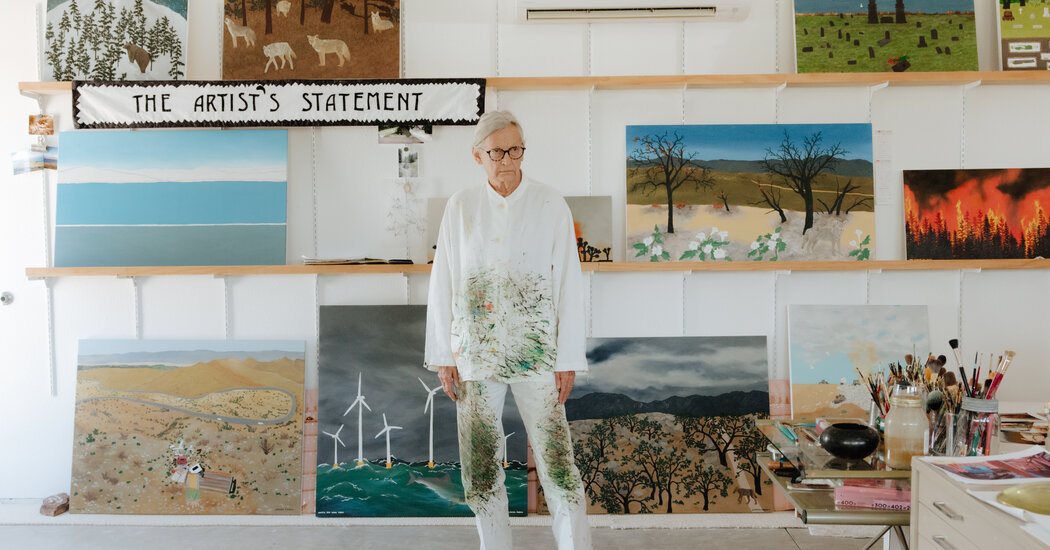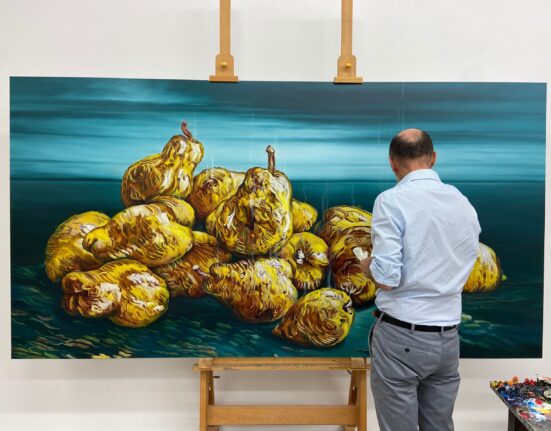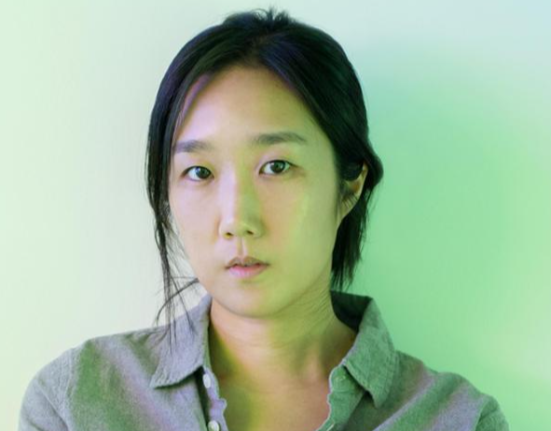On a sunny autumn morning, in Jessie Homer French’s garage-studio, up several miles of mountain switchbacks from Palm Desert, Calif., a dozen canvases are propped on shelves in various stages of completion. Most are landscapes. Three depict cemeteries, a recurrent subject for the 83-year-old self-taught artist. Standing out among the browns and the greens, however, are two pictures of wildfires, in furious tones of orange, yellow and black.
Leaping infernos have lit up Homer French’s paintings for years. In “1st Presbyterian” (1994), flames lick through the door jambs of a white-painted church. In “Slash + Burn” (2000), smoke curls up from freshly set fires in a recently deforested woodland. In the more dramatic “Boreal Burning” (2022) — five feet wide — the sky above burning trees is dark with smoke. In “Blowout” (2020), it’s an oil rig that is combusting.
In Homer French’s exhibition “Normal Landscapes,” opening Jan. 16 at Various Small Fires gallery in Los Angeles, we observe only the aftermath of fires. In one new painting, “After Burn and Jimson Weed,” wildflowers bloom from the scorched earth. In another, “Lower Rush Creek” (1994), blackened tree trunks spike into the sky while trout leap from the water. Life finds its way through the desolation.
“Everybody keeps saying that I paint fire because Ed Ruscha was a friend of ours, and he always painted fire,” says Homer French, referring to the eminent pop conceptualist whose retrospective at the Museum of Modern Art included paintings of both Norms diner and the Los Angeles County Museum of Art aflame. “Actually, I started painting fire in the ’80s. I was hiking through a friend’s ranch one day in Franklin Canyon, in Beverly Hills. I saw prisoners working with firemen, doing a prescription burn. It was so beautiful.”
Homer French resides in a mountain wilderness, dry and sparsely populated, with panoramic views that include hazy intimations of gridded settlement in the flatlands below. It is high desert; ocotillos, scrubby junipers and sagebrush bushes dot the earth between the pinyon pines that give her unincorporated community its name.
Pinyon Crest is hidden from the highway, and its residents live largely hidden from one another. To get there, most visitors will drive up from Palm Desert, a Coachella Valley city dominated by golf resorts and gated communities. In Pinyon Crest, and in its adjacent settlement, Pinyon Pines, one senses that the residents have rejected clubbiness in favor of invisibility and anonymity.
Homer French, who was born in New York, moved to the high desert seven years ago with her husband, the British talent agent and movie producer Robin French. After his retirement in 1996, she tells me, “Robin’s gypsy feet” took the couple from Beverly Hills to Vancouver Island to western Oregon to La Quinta, a resort city close to Palm Desert — “but it was too suburban for Robin. He just couldn’t bear it.” Instead, up in the Santa Rosa Mountains, they found a Pueblo-style home with a pool and a spectacular view. Since Robin died in 2021, at 84, Homer French has lived here alone, without internet or a cellphone. (“They will destroy humanity,” she tells me.) Her assistant, Nich McElroy, visits once a week, to relay emails and manage her newly flourishing career.
Straight backed and with birdlike poise, Homer French projects a pioneer self-sufficiency, as if she’d be equally capable of darning a sock, milking a goat or driving a horse-drawn cart. It’s little surprise that she’s an avid fly-fisher, and, before Robin’s death, would spend up to 100 days a year standing in rivers in the eastern Sierras, or in Oregon or British Columbia, casting dry flies over trout. Still, she claims, “I’m a complete incompetent. Robin took care of everything. I don’t think I can live up here alone any more. It’s really tough.”
For most of her life, Homer French worked without much expectation or hope of attention or sales or critical acclaim. When she sought out a gallery, in the 1970s, it was only because paintings were piling up in her studio and she needed them out of the way. She seems mystified that an artist would want anything other than to be left alone to paint.
“I paint my life, my stuff. I really, really care about the painting turning out. I’m really upset when it doesn’t. But I don’t feel any need to communicate. I’m sorry. That’s not the point.”
It was Robin who drew attention to his wife’s paintings. Credit also goes to an old friend of theirs, the artist Billy Al Bengston, who introduced her work to his gallerists, Esther Kim Varet and Joseph Varet, of Various Small Fires (named after a book by Ruscha). Since 2017, when she first exhibited there, her work has reached audiences around the world. Last summer, two of her paintings were reproduced as billboards beside the High Line in New York. In 2022, she exhibited in the Venice Biennale, and last fall a selection of her recent paintings was included in the Hammer Museum’s biennial “Made in LA.” Both of those surveys proposed alternative narratives of art, elevating the work of variously female-identifying, self-taught, geographically dispersed or Indigenous artists and makers. Homer French’s paintings fit right in.
The less Homer French knows about the business side of her career, she says, the better. “I’m not sure that financial success is good for a painter. It might be good for somebody who’s making something really complicated, like balloon dogs,” she says, winkingly, referring to the expensively produced sculptures of Jeff Koons. “But for a regular ordinary painter who hangs out in her garage, and desperately tries to make something that she likes, I don’t know if a lot of success would be good for them.” She adds, “It won’t change me at all.”
Since Robin died, Homer French tells me, she has fished only rarely. I too like to fish, and Homer French said that there were trout in Lake Hemet nearby — big ones, including the freakishly bright yellow “lightning trout,” a genetic mutation that is stocked in certain lakes and reservoirs. She agreed to take me. She also warned that on such an unseasonably warm day we probably wouldn’t catch anything.
Accompanying us was her son, Spencer, 51, a financial adviser in Portland, Ore. In his Jeep, bouncing down the unpaved road to the highway, Homer French told me that she has always fished; she remembers catching a smallmouth bass in a creek with her hands when she was about 3 years old. When she was 5, toward the end of World War II, her father — a German émigré — relocated his family from New York City to a rustic cabin in the Adirondacks because he was convinced the Germans would bomb the city. An only child, she was left to roam the countryside. “There weren’t any phones,” she says. “I remember when I was 12 two guys came and put big poles up the valley, and then we got electricity. Before that, it was just me and the wilderness. It was great!”
When Homer French was 18, she moved to New York City with a boyfriend. Modeling was an expedient way for her to make money. In the 1960s, she appeared in a swimsuit issue of Sports Illustrated and began saving her money with the ambition of working full time as an artist.
Her first marriage, to an actor, took her across the country to Los Angeles; when they were divorced she rented a tiny hillside cabin in Echo Park. It was there that she met Robin; introduced by friends, he knocked on her door one day when she was sick with a fever and proceeded to care for her. They were engaged just a few weeks later, and married on Valentine’s Day in 1969.
For their honeymoon, Robin’s clients Richard Burton and Elizabeth Taylor offered their property in Puerto Vallarta, Mexico, where they met Bengston. (“It was a big place,” Homer French says.)
Through him, they met other colorful personalities of the “Cool School” art scene that had cohered in the 1960s around the Ferus Gallery and the scruffy beach neighborhood of Venice. The Frenches bought a house on two and a half acres in Coldwater Canyon, in Beverly Hills, adding a subterranean guesthouse and a screening room. Robin rescued a condemned decagonal burger stand from a strip mall and resurrected it in the garden as a painting studio for Jessie.
“Our gates were always open,” she recalls. “People would come and play tennis and swim and eat and drink and play with the children and take eggs from the chickens. It was a different world.” Artists including Ruscha, Bengston, Charles Arnoldi, Joe Goode, and Don Bachardy (with his partner, Christopher Isherwood) were all regular guests at the Frenches’ dinner parties and movie screenings.
Homer French’s folksy paintings seem to have almost nothing in common with her friends’ experiments with unconventional subjects and media. In an essay in Homer French’s new monograph, the curator Francesco Bonami writes that her paintings “emanate the luminosity of a relentless optimism.” Her lack of art-school education may have set her apart but, Homer French points out, every artist is self-educated. (She learned from a book Bengston gave her, Ralph Mayer’s “The Artist’s Handbook of Materials and Techniques,” which she uses to this day.)
Homer French can be self-deprecating. “I can’t draw,” she says, “although I do try.” Her anti-perspectival pictures — scant shadows, crisply delineated forms — are often compared to the work of folk artists or naïve painters, from Grandma Moses to Henri Rousseau (whom Homer French admits as an influence). The large fabric “mapestries” that she embroiders with topographical details add to her affiliation with traditional craftspeople. But the modern, compositional directness of Alice Neel, R.B. Kitaj and Alex Katz is also reflected in Homer French’s work.
When she paints white wind turbines or Stealth bombers (both recurrent motifs) it’s hard to tell if they are emblems of human abasement or objects of beauty. Despite their narrative clarity, I comment, her viewpoint is rarely clear. “To you or to me,” she responds.
AT LAKE HEMET, Homer French pulls from her vest pocket a small box marked “lake flies” and settles on a fluffy, olive-green “woolly bugger.” Fly-fishing on the water’s surface appeals to her because it’s easier to release fish unharmed than with bait fishing. “You feel like you’re discovering the mystery of what’s hidden underneath the water. ”
Many of her paintings are structured around this division between the visible world and what lies beneath. In “High Country Brookies” (2020), the canvas is neatly bisected to show the mountain landscape above the water and the trout within it. And there are several paintings of cemeteries in which coffins are shown under the ground, their occupants lying peacefully inside. The mystery of death is as impenetrable as the depths of a cold mountain lake.
It’s frustrating fishing; a breeze whips across the lake, tangling my line, but never cooling the water enough to entice the trout close to the shore. Homer French is not dispirited, even after we decide to stow our rods and climb back into Spencer’s Jeep.
On the journey home, Homer French remarks on the greenness of the sagebrush, after one of the wettest years in recent memory. A few weeks before, Tropical Storm Hilary had caused flooding, mudflows and a sinkhole in the Coachella Valley. Homer French has five grandchildren and, given her preoccupation with climate change and war and the human degradation of the natural world, she says, “Every time a new member of the family comes along, I think, ‘Well, there’s one more person to worry about.’ In the ’60s and ’70s, a lot of us actually thought the world was becoming a better place, and there might even be an end to war. What dummies we were, huh?”
Spencer says: “You let me know that you never stopped worrying about your children. You also lost your firstborn child. That had a profound effect on you.” Homer French tells how her daughter Valentina was born in 1970 with cerebral palsy, and lived only until she was 6. “Funeral” (1978), which depicts a fresh grave piled with flowers and a gaggle of mourners, was the first time Homer French would paint a cemetery, a matter-of-fact record of indescribable sadness.
Then we pass ribbonwood trees, and she notes that they have a lot more flowers this year than usual. “It sure is pretty up here though, isn’t it?”
More than an elegy to what has been lost, Homer French’s traditional-seeming work — like her life — looks to the future, and finds ways to honor beauty in a world inclined toward devastation.







